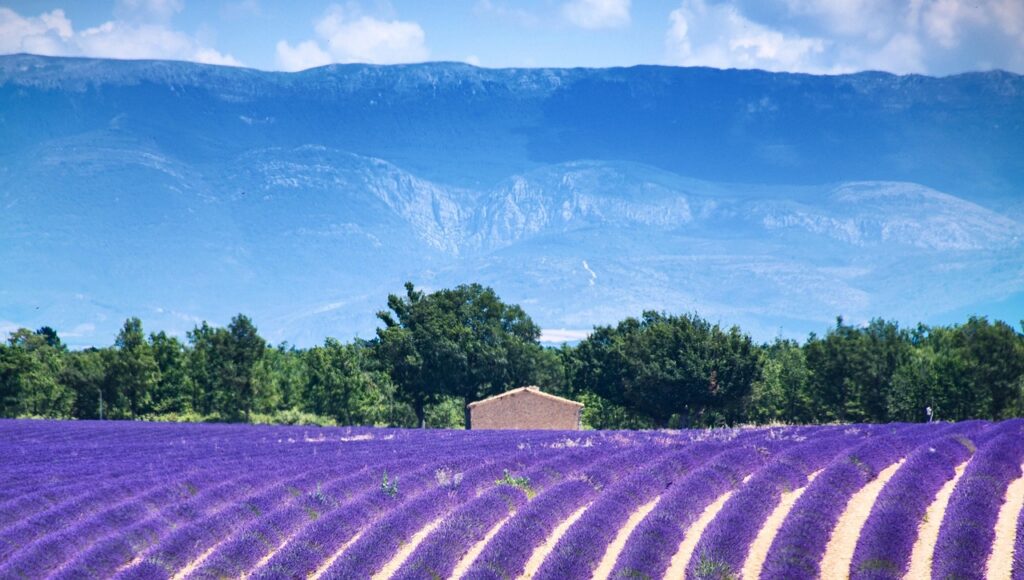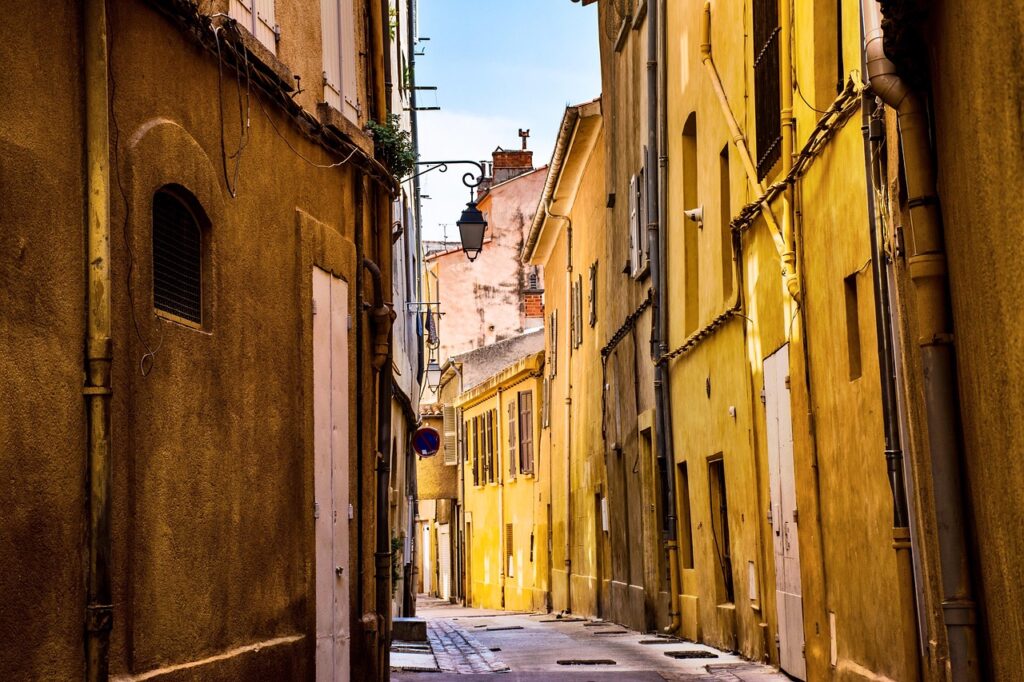Somewhere between Avignon and Grasse, where the sun hums low over the hills, summer stirs a secret into bloom. It begins not with fanfare, but with fragrance. A sweetness in the air as if time itself has perfumed the morning. Come June, Provence paints in its rarest hue: lavender, soft as a whispered promise, bold as a forgotten memory coming home.
The fields unfold like purple oceans, each bloom a tiny brushstroke in a masterwork of solitude and scent. They ripple in waves beneath the mistral’s breath, moving as one body, sighing as one heart. It is not merely color, it is reverie. A dream that has taken root, risen, and stretched towards the sun in defiance of ordinary days.
Amid the rows, the bees conduct their quiet ballet, weaving golden thread between violet spools. They do not hurry. Nothing here does. Even the light slows, warming the stone walls of ancient farms and kissing the tops of rosemary hedges, as though Provence has asked the day to stay just a little longer.
Stone chapels blink drowsily in the glow, guardians of centuries, cradling echoes of old prayers and the rustle of lace at village fetes. And here, in this fragrant tapestry, every breath is thick with sunlight and herb, sky and soil. To walk these fields is to move through poetry made tangible. Each step a verse, each scent a refrain.
As evening approaches, lavender deepens. Becoming smoke, amethyst, indigo. The sun, impossibly gentle now, tucks itself into the hills with a contented sigh. And the fields, bathed in twilight, seem to hum. Not loudly, but like a lullaby remembered from childhood. Half melody, half magic.
In this hour, Provence speaks not with words but with presence. You do not visit lavender. You become a little lavender yourself. Rooted for a moment, breathing in the hush, swaying with the wind, and surrendering to the sweet, fleeting beauty of summer in bloom.
The Identity of Lavender
Not everything that paints the landscapes of Provence in blue and purple is true lavender. Botanical precision distinguishes real lavender, technically Lavandula angustifolia, from its lookalike relatives. True lavender grows only at higher elevations, found above 800 meters, and in France, its heartland is the southern slopes of the Sault and Albion plateaus. These regions alone account for the bulk of the French lavender harvest. The plant itself is notable for a singular flower panicle per stem, distinct from its larger relatives. Achieving even a single liter of essential oil demands a harvest of approximately 130 kilograms of these flower panicles, a testament to its potency and value.

Differentiating Lavender Varieties
Within the fragrant fields of southern France, several Lavandula species thrive. True lavender, as described, is the most prized for its high-altitude origin and subtle scent. In the lowland garrigues, dry shrub heaths between 0 and 600 meters, grows spike lavender (Lavandula latifolia). This cousin is a much larger plant, carrying several flower panicles per stem and exuding a distinct, camphor-rich aroma.
Since the 1950s, the valleys have also welcomed lavandin, a cultivated hybrid between spike and true lavender. Lavandin is recognized by its tufted blooms and a powerfully aromatic fragrance, now intimately associated with sachets and the characteristic provincial scent.
Extraction and Use of Lavender Oil
The value of lavender extends beyond its visual beauty; its essential oil is among the most cherished in aromatherapy and perfumery. The extraction typically follows a traditional distillation method: fresh flower panicles are steamed in an alembic, releasing their volatile oil, which rises and is collected in a flask of water. Because oil is lighter than water, it settles as a distinct layer on top, allowing easy separation and collection. This labor-intensive process underscores the rarity and quality of pure lavender oil.
The Name and Legacy
Lavender’s name is rooted in history, with “lavandula” borrowed from Middle Latin, itself derived from the verb “lavare,” meaning “to wash.” Historically, lavender blooms enhanced bathwater and laundry, imbuing both with their enduring fragrance and purportedly with cleansing properties.
The origins of lavender remain elusive; some accounts suggest it arrived in the Mediterranean from Persia or the Canary Islands. Its spread eventually extended from Central Europe to the Near East and beyond as far as New Zealand, carried on the hands of gardeners and apothecaries alike.
Spiritual and Cultural Dimensions
Beyond the physical, lavender is often ascribed spiritual qualities. Its soothing scent and calming color are said by esotericists to foster intuition, encourage spiritual release, and promote self-acceptance and individuality. To some, the plant is a source of inner purification and clarity.
Even in the earliest civilizations, lavender served not only as a valued perfume but also as a spiritual symbol. The Greeks dedicated lavender to Hecate, goddess of magic and transformation, while in various parts of Europe, sprigs were believed to ward off the “evil eye” and were strewn in churches and homes on certain saints’ feast days. These traditions exemplify lavender’s dual role as both sanctified and protective.
From Ancient Baths to Victorian Parlors
Historical records are peppered with mentions of lavender’s uses and symbolism. In the first-century “De materia medica” by Dioscorides, lavender is both a medicinal herb and a perfume. The Codex Juliana Anicias, an illuminated manuscript from the early sixth century, features crested lavender among its 383 plants, while medieval texts such as the Lorsch Pharmacopoeia and the New vollkommenlich Kräuter-Buch (1664 edition) detail various species and their applications, from medicinal syrups to flavored oils.
The Renaissance brought new visual tributes. The Book of Hours of Anne de Bretagne (1503–1508) features botanical illustrations of spike lavender. During this flourishing era, herbs and aromatic plants, including lavender, were cultivated for their role in culinary, medicinal, and domestic life.

Ancient Egypt, Greece, and Rome
Lavender’s value transcends time and culture. In ancient Egypt and Turkey, its clean, refreshing scent was prized; Arab women reputedly used its oil for glossy hair. Romans, too, cherished lavender for their bathhouses, hence the plant’s association with washing. The ancient Greeks extolled its fragrance, with Dioscorides commending lavender oil’s superiority over other perfumes, and Greek myths entwine lavender with the divine.
Medieval and Tudor Europe
In medieval Europe, dried lavender flowers filled pot-pourris, sweet-bags, and tussie-mussies, and served to keep clothing and linens fresh and moth-free. In the Tudor era, quilted jackets and caps were often stuffed with lavender, while Queen Elizabeth I encouraged the sewing of lavender sachets into skirts.
It wasn’t until the late 16th and 17th centuries that the art of distilling essential oils, “chymical oils”, from lavender became a household skill. Stillrooms became the domain of many a house mistress, where rushes and lavender were transformed into a myriad of aromatic goods, from lavender water to sweet bags and herb pillows.
Victorian Obsession
Lavender’s allure persisted into the Victorian age, when it became nearly synonymous with notions of gentility and refinement. Women carried vinaigrettes, small scent containers with vinegar and lavender-soaked sponges, as protection against unpleasant odors. Queen Victoria herself was an aficionado, using lavender oil as both a disinfectant and polish for furniture. This era gave rise to iconic nursery rhymes like “Lavender’s Blue,” and cemented lavender’s nostalgic status in Western culture.
Perfumery and Industry
Lavender oil remains central to perfumery. Its multifaceted aroma, at once potent and delicate, blends exquisitely with citrus oils such as bergamot, forming the backbone of countless colognes and fougère fragrances. Historic companies like Yardley built their legacy on lavender, producing soaps and perfumes that defined generations of scent, with Norfolk Lavender Ltd supplying English lavender oil since 1936 for use in everything from classic scents to everyday toiletries.
Despite associations with old-fashioned sachets gifted by maiden aunts, the fragrance of lavender has, at various times, served as a calling card for women of all social manners, from gentlefolk to those advertising more provocative trades. This diversity only adds to its mystique and enduring appeal.
Lavender in Medicine
Lavender’s healing reputation is ancient, documented as early as Greece’s Materia Medica. Dioscorides and his contemporaries prescribed lavender teas for chest complaints, antidotes for poisons, and even for psychic malaise. The Romans used both true lavender and French lavender (Lavandula stoechas), distinguishing between their uses in perfumes and incense, particularly in religious and childbirth ceremonies.
Monastic Europe preserved and expanded herbal lore, with abbesses and monks detailing lavender’s use as a disinfectant, treatment for lice, purifier of character, and believer in its spiritual protection. By Shakespearean times, lavender, along with mint and savory, was a staple of classically arranged herb gardens.
Enlightenment, Decline, and Revival
Though lavender’s role as a folk remedy waned with the rise of chemical medicine in the 18th and 19th centuries, its therapeutic value was never completely forgotten. The 20th century renaissance of herbalism, marked by the publication of A Modern Herbal, saw lavender recognized once again for its nerve-calming, antiseptic, bactericidal, and wound-healing properties. Indeed, French clinical practice made extensive use of lavender oil in military hospitals throughout both World Wars for its remarkable effectiveness against infection and as a domestic remedy.
René-Maurice Gattefossé’s pioneering work in France established the medical credibility of lavender oil and gave rise to the term “aromatherapy.” Advocates like Marguerite Maury further highlighted its rejuvenating and psychologically balancing powers, integrating lavender oil into the mainstream of complementary medicine, particularly in massage therapy and nursing care.
Therapeutic Applications of Lavender
Versatility in Healing
Lavender oil is renowned for its versatility:
- Skin Care: Its antiseptic, anti-inflammatory, and wound-healing qualities make lavender a staple in treating cuts, burns, and stings. It also aids common conditions such as acne, eczema, and various skin irritations.
- Pain Relief and Soothing Effects: Lavender’s potent analgesic and muscle relaxant properties lend relief to ailments like rheumatism, arthritis, cramps, and headaches.
- Stress and Nervous System Support: Unrivaled in balancing, lavender acts as both a tonic and sedative on the nervous system, proving equally useful for calming hyperactivity or combating fatigue. It is frequently deployed to address stress-related conditions, depression, palpitations, and tension headaches.
Lavender is noted as an “adaptogen,” able to gently restore equilibrium by warming or cooling the body as needed, and is thus uniquely effective for psychosomatic complaints and immune depletion related to stress.
Additional Benefits
Beyond its primary actions, lavender oil offers:
- Fungicidal and Protective Functions: While less potent than tea tree oil, lavender serves as a mild immuno-stimulant and preventative remedy against infections and fevers.
- Anti-toxic and Insecticidal Uses: It is a traditional defense against bug bites and stings, used to repel mosquitoes and moths for generations.
Lavender in Cuisine
The culinary reputation of lavender is lesser known but growing. Only real lavender (Lavandula angustifolia) is used, prized for its aromatic flowers and leaves. These are employed, like rosemary and thyme, in the famed “herbs of Provence” mixture. Lavender panicles can flavor meats, fish, ice creams, cakes, teas, lemonades, and honey. However, caution is essential: spike lavender imparts an intense, soapy note that can overwhelm dishes.
Lavender’s journey traverses continents and centuries, linking the ancient world’s baths and herbals with modern spas and kitchens. Its enduring value lies not only in the allure of its fragrance and the subtle beauty of its blooms, but also in its remarkable effectiveness as a remedy, a culinary herb, and a cultural symbol of clarity, comfort, and renewal. As the world continually rediscovers the harmony and healing embodied in lavender, this cherished plant remains a testament to nature’s elegance, resilience, and mystery.
Images: Lens_and_Light, stills_by_suki.
If our work has inspired you, helped you grow, or simply brought a little warmth to your day, consider supporting Thalysia.com with a small donation. Your contribution helps us continue exploring ancient landscapes, documenting local traditions, and celebrating the art of living well.
